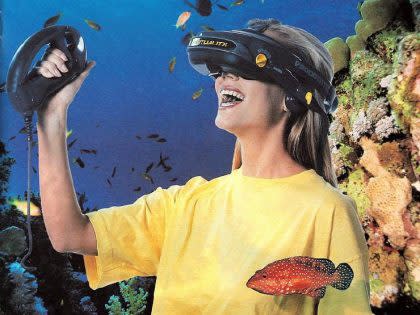Why virtual reality will live up to the hype
In the 90s virtual reality was hailed as the next big thing, but the experience was far from perfect. The VR world was buggy and laggy, and the hardware was nowhere near where it needed to be to give viewers an immersive experience. And VR went away quietly, with little fanfare.

Now, as we approach 2017, virtual reality is back in a big way, with companies like Samsung, Facebook, Sony and Google betting big on the medium. In fact, analysts at Goldman Sachs see it as an $80 billion industry by 2025.
Just in the past couple weeks, ahead of the holiday shopping season, Sony released what could be the biggest game-changing product to hit the VR industry: PlayStation VR. Google, not to be outdone, launched its Daydream mobile VR software with its accompanying set of goggles and motion controllers. Samsung, meanwhile, ramped up its investment in mobile VR through its partnership with Oculus and its Gear VR headset.
But a big question still remains: Can the technology live up to its potential?
David Mullett, founder of virtual reality content agency Virtualize, says VR creators are just scratching the surface when it comes to the potential for the platform.
“If you really look deep into what this new phenomenon is all about, you can look back to the early days of human storytelling around the campfire,” he says, adding that like campfire storytellers, VR creators can build vivid worlds in viewers’ minds. But with VR, those images are created in near lifelike simulation in 3D with 360 binaural audio.

The technology isn’t just limited to storytelling, however. VR worlds can become a place where one can create an avatar and have virtual interactions with others in real time, and even conduct business. “It’s something of a digital parallel dimension,” Mullet says, “where commerce, communication, and entertainment take place.”
From a commerce perspective, a select number of advertisers and brands have been creating experiences for viewers, concepts that either tell a story about the brand (for example Patron’s “Virtual Hacienda Tour”) or put the viewer in the eyes of a dynamic performer (with Nike’s soccer’s “Neymar Jr. Effect”).
While brands look to capitalize on VR, it will be the companies behind the hardware, most notably the chip makers, who stand to benefit as VR matures. “The chip makers definitely have an incredible position in the VR ecosystem,” Mullett says.
Can VR live up to the hype?
Ahead of the holiday shopping period, reports on sales of VR hardware point to a slow start. But it’s still in the early days, and the big players behind VR – Sony, Facebook, and Samsung – are vowing to be in it for the long haul. And that could the big difference this time around for the future of VR.
“We’re talking about new hardware, new cloud-based computation systems. We’re talking about new delivery devices,” Mullett says.
And that is the bet – that improving software and hardware technology will keep pushing the VR experience further – making that global campfire that Mullett described bigger and brighter.
“VR is going to change everything,” Mullett concludes. “In a bigger way than anyone can even imagine.”

